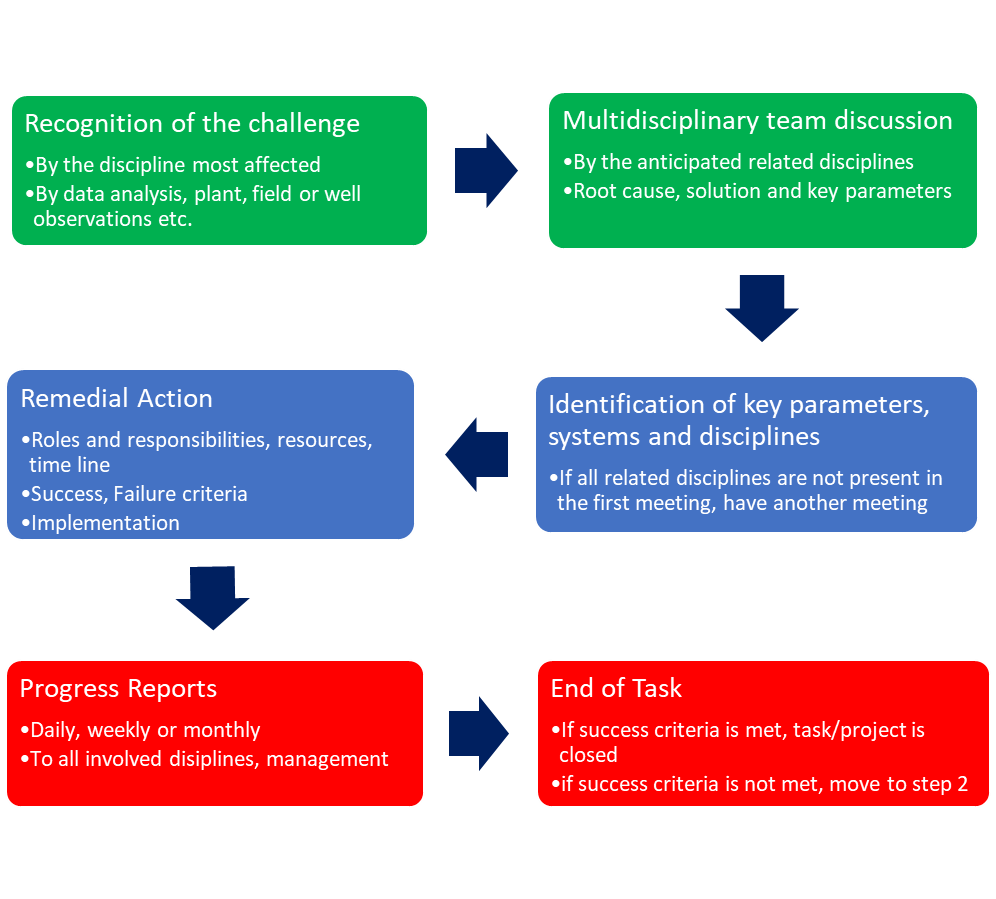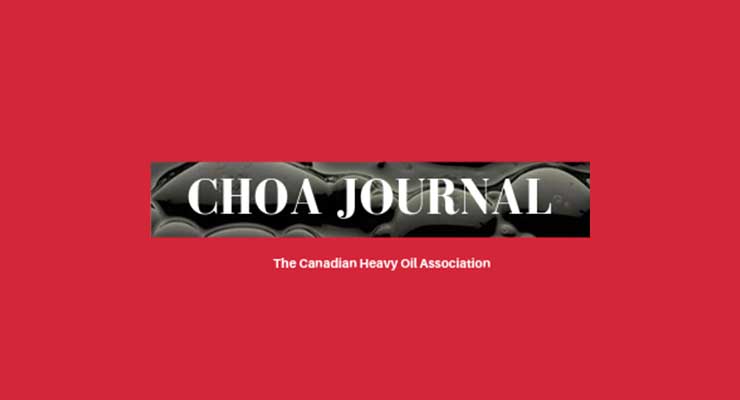A Systematic Multidisciplinary Approach for Optimization in Brownfield SAGD Projects – Part 1
Shahbaz Masih, P. Eng. and Mark Savage P. L. Geo.
Introduction
Operators of oil sands projects need to be cautious about capital intensity and have built-in operational efficiencies, especially in a low oil price environment. Capital intensity is equally important for new projects (greenfield) and projects in operation (brownfield). Steam oil ratio (SOR) and oil production rate are the main parameters that determine the economics of a steam assisted gravity drainage (SAGD) project. Both are influenced by reservoir characteristics, well placement, design, completions, and surface and subsurface operational practices. Optimization of greenfield and brownfield projects in any of these parameters can improve the SOR and oil production rate. Improvement in oil production and SOR of brownfield projects can be attained by either optimization of existing wells or adding more wells, e.g. infill wells, extension wells, farmer wells ( new hz wells above base of pay and below the hz production well), and sustaining well pads. Previous studies have examined parameters that could impact optimization of SAGD performance at different stages of the process, e.g. by Gittins et al2, have evaluated modification of SAGD process by using solvent co-injection, e.g. by Gupta et al3, and proposed improvement of the process mechanism, e.g. by Edmunds et al1.
In this article, the SAGD process is broken down into surface and subsurface systems to ensure a systematic approach across disciplines to look for suitable optimization solutions. The systems approach facilitates root cause analysis by identifying the critical parameters and the disciplines involved. This systematic approach also helps form a multidisciplinary methodology to address operational issues.
This article is divided into multiple parts. Part one will focus on the systematic multidisciplinary approach for optimization of brownfield projects and explain, with examples, how this operational approach can be used. Part two, to be published later, will focus on brownfield SAGD optimization using the multidisciplinary approach for adding more wells such as drilling infill, pad extension, and farmers.
Multidisciplinary Approach for Optimization
Systems, Disciplines and Their Roles
SAGD projects consist of complex surface and subsurface entities. It is prudent to break a project into major systems, identify the disciplines responsible for oversight of those systems and use a multidisciplinary approach for optimization. SAGD projects in the operation phase consist of the following major systems (Figure 1).
- Water supply system that provides water for steam generation can consist of source water wells, aquifer, ponds, and booster pumps;
- A series of well pads placed throughout the pool and well completions which can include wellhead, casing, tubing, artificial lift, and flow control devices;

Figure 1: Main components of a brownfield SAGD Project
- The Reservoir includes reservoir fluids and reservoir rock (framework, matrix and clays);
- An oil treatment system that separates bitumen from water, gas and other impurities and adds diluent to bitumen can consist of an inlet degasser, free water knockout (FWKO) vessels and oil treaters, including associated chemical feed systems;
- A bitumen storage and delivery system where bitumen is diluted for storage and delivery, can consist of storage tanks, loading terminals, trucks or pipelines;
- A water treatment system that can include skim tanks, induced gas flotation (IGF) units, oil removal filters (ORFs), warm lime softeners (WLS), and ion exchange (IX) water softeners. The processed water is recycled and sent to steam generation system; and
- A disposal system can consist of disposal wells, and/or disposal trucking.
These systems work holistically to achieve a fully optimized SAGD operation. For example, if disposal by trucking or injection is halted for a substantial period, it directly affects the amount of steam injected into wells. Depending on steam chamber maturity and the duration of the disposal issue, this could affect steam chamber pressure, oil production rate and SOR resulting in suboptimal or even disrupted operation. The impact of these effects on a project’s economics can be minimized by using a multidisciplinary approach and preplanning for these situations. An increase in SOR and a decrease in bitumen production can be minimized by producing from the wells that are less steam intensive and have a low water cut to generate minimum disposal volumes. A multidisciplinary collaboration by reservoir engineering, production engineering and the site operations is needed to build an optimization plan.
During the operation phase, geoscience, reservoir engineering, production engineering, drilling and completions (D&C) and site operations and maintenance (O&M) are the key players. The role of each discipline in the major elements of a SAGD project operational phase includes but is not limited to, those illustrated below in Figure 2. For optimization to generate an effective and positive impact on the project economics, a multidisciplinary approach is required.

Figure 2: The roles of different disciplines in the operation phase
Optimization Methodology
Root cause analysis and remedial action are key to solving most technical problems. The analysis, evaluation and implementation of potential solutions should be a collaborative effort coordinated by the discipline assigned to the task. After identification of the root cause, the remedial action should be executed in collaboration with all related disciplines. Remedial action should include the economic justification, roles, responsibilities and timelines. If the diagnostics and remedial action consist of several steps, the execution can be tuned to the availability and readiness of the facility equipment related disciplines. The disciplines should be kept informed of the results of the remedial action until the end of execution and follow up assessment. If the issue is not resolved, other remedial actions should be discussed by the multidisciplinary teams (Figure 3). The multidisciplinary approach will be discussed in more detail by using examples in the discussion section.
Examples and Discussion
Example 1: Inefficient steam chamber conformance along the length of the well in early SAGD phase
Poor steam chamber conformance is a significant challenge in SAGD operation. It is recognized by cold intervals or high subcools along the horizontal well length after start-up (6 months – 3 years of SAGD phase). Conformance impacts the two key economic parameters, oil production and SOR. Heat distribution along the well length depends on quantity of heat delivered by steam and its propagation into the reservoir.

Figure 3: Multidisciplinary approach for optimization
Heat distribution is influenced by steam injection rate, steam quality, well/completions design, steam injection strategy and the reservoir geology. Figure 1 shows these parameters belong to steam/power generation system, wells/well pads operation and reservoir characterization. Reservoir and production engineering disciplines manage wells/well pad operation. O&M controls the steam/power generation system. Reservoir characterization is conducted by geoscience (Figure 2). Collaboration of the disciplines concerned is needed on the remedial action to determine the economic viability and strategize to implement the solution.
Because steam injection strategy and rate can be easily modified, and steam quality can be tested, these parameters can be investigated first to look for solutions. If the wellhead steam quality is suboptimal, steps should be taken to improve the steam quality, e.g. safely lowering steam generator pressure. After confirming good steam quality, then steam injection rate and strategy should be investigated, e.g. injection pressure and a sufficient split of steam between the heel and toe.
Geoscience should revisit reservoir characterization. If reservoir geology is found to be suitable for steam propagation and steam quality is optimal, the next course of action lies with reservoir and production engineering. However, if reservoir geology isn’t suitable for steam propagation, as characterized by the horizontal log while drilling (LWD) data, observation well data, and 4D seismic surveys or other geoscientific tools, then well design modification options should be evaluated to optimize resource recovery. Figure 4 illustrates how variations of reservoir top of pay and base of pay can lead to uneven heat distribution along the well length and poor steam chamber conformance.

Figure 4 Uneven heat distribution caused by reservoir characteristics
D&C manages the well design modifications, and should be included in the identification of solutions and remedial actions. Modification of well design should be reviewed by all disciplines based on respective roles and responsibilities, e.g. economic viability and installation of tubing deployed flow control devices or modification of injector or producer tubulars. For example, geoscience can update the geological model for studying well design modification options with reservoir simulation done by reservoir engineering. D&C can look at the operational viability of the proposed well modification. Production engineering can share learnings and observations from historic well operations, such as steam breakthrough, to analyze proposed solutions and economic viability. After implementing the well modification, disciplines should be updated with new results of the heat propagation analysis, e.g. temperature logs, and well performance (oil production rate and SOR). If the well modification improves heat distribution along the well length and enhances production, the multidisciplinary optimization can be considered complete. If heat distribution has not improved after the well modification, then alternative remedial actions can be reinvestigated with a multidisciplinary approach.
Example 2: Water treatment issues
Produced water with emulsion is treated and recycled to generate steam. The Alberta Energy Regulator (AER) put limits on makeup water and water disposal volumes. Water treatment issues can limit the amount of total fluid produced (Figure 1), which can impact wells and well pad operations, steam generation system, water disposal system, water supply system and bitumen storage and delivery system. The severity and duration of these issues can pose a significant challenge in maintaining production, steam supply and meeting production and budget targets. The water treatment system can have a range of mechanical and chemical issues. Analysis, evaluation and remedial action associated with these issues can take time. Some issues can be resolved with reduced production from wells/pads and others need total plant and production shut down.
O&M handles the water treatment system and should coordinate the resolution. Because, water treatment issues are impacted by the volume of produced water, its temperature and chemical composition, reservoir engineering and production engineering should be involved in analysis of the produced fluids. If reduced production of total fluid is required, then the volume of produced water is critical. To keep the oil production high, the production can be limited to low water cut wells. Well selection can be coordinated between reservoir and production engineering. Since low water cut wells usually make the most efficient use of steam, it can help to achieve the most efficient oil production and SOR. A proactive measure to address various production scenarios would be to build and provide dynamic well lists to O&M. If the issue prevails for too long, the steam shortage will require changes in steam volumes to individual wells. The most efficient use of steam based on the well’s performance and operational strategy, can be managed with collaboration between reservoir and production engineering. To efficiently and safely manage steam quantity and quality, O&M (steam generation) should be involved in discussion of the steam cuts. Also, O&M (bitumen storage and delivery) should be involved to manage the impact on bitumen sales and on diluent usage. Water management team can be informed of changes in makeup water usage and disposal rates to keep processes aligned with the regulations depending upon the severity and timeline of the issues.
Example 3: Low subcool issue
The systematic and multidisciplinary approach for low subcool has been divided into two parts.
Evaluation of recommended low/optimum subcool: A well going into low subcool mode can be a major challenge to bitumen production. The optimum subcool can be defined by a collaborative analysis of operational parameters by reservoir engineering and production engineering including:
- Fluctuation in pump current draw and emulsion production rate;
- Pressures at the heel and toe of the producer;
- Temperatures along the producer;
- Reservoir subcool (based on steam chamber pressure);
- Simulation results for optimum subcool considering heat efficiency;
- Phase behaviour to differentiate between gas and steam; and
- Well test results to identify changes in production at different subcools.
These parameters help operators to identify the difference between gas and steam influx, keep the integrity of the liner and other equipment intact, and perform the economic and risk analyses of running at low subcools. Since the recommended low subcool involves an analysis of so many parameters, it can vary from one well to another. In consideration of the impact on economics and on the business model, tolerance for running at a lower than optimum/recommended low subcool limit can be discussed with management
Operational challenge: Running a well at a lower than recommended subcool limit can compromise well integrity, lead to costly well repairs/redrills and lower the oil production. Production engineering is accountable for achieving production goals. Production engineering should coordinate and manage the well integrity and operation, and the optimization process. During operations, subcool along the well length is influenced by the balance between well productivity, withdrawal rates, and heat distribution along the well length. Heat distribution depends upon steam injection rate, steam quality, well/completions design, steam injection strategy and the reservoir geology. The unevenness in heat distribution can be resolved by modifying well design or operational philosophy by using a multidisciplinary approach as discussed in Example 1. Well productivity depends upon reservoir characteristics, e.g. pay thickness and quality, reservoir heterogeneity, and permeability, and is determined with reservoir analysis by reservoir engineering, production engineering and geoscience. If the withdrawal rates are too high compared to well productivity, sometimes even at the lowest pump speed, the next pump deployed should be designed in consideration of updated well productivity data and in coordination with D&C.
Conclusions
Brownfield SAGD projects are a complex and integrated mixture of surface and subsurface equipment and facilities. It is prudent to break these complex projects into functional systems. This systems approach can help root cause analysis and planning optimization strategy. A systems approach can also help form a multidisciplinary methodology to address operational issues. The effective multidisciplinary approach requires good communication between disciplines involved and the development of processes across organizations to use the best available expertise in each discipline for root cause analysis, planning and implementation of remedial action and for determination of criteria for success.
References
- Edmunds, N., and Gittins, S., “Effective Application of Steam Assisted Gravity Drainage of Bitumen to Long Horizontal Well Pairs”, Journal of Canadian Petroleum Technology, 1993
- Gittins, S., Gupta, S., and Zaman, M., “Simulation of Noncondensable Gases in SAGD Steam Chambers”, Journal of Canadian Petroleum Technology, 2011
- Gupta, S. and Gittins, S., “An Investigation Into Optimal Solvent Use and the Nature of Vapor/Liquid Interface in Solvent-Aided SAGD Process With a Semianalytical Approach”, SPE Journal, 2013
About the authors.

Shahbaz Masih is APEGA registered professional engineer with M.Sc. from University of Regina (Canada) and B.Sc. from UET Lahore (Pakistan), both in Petroleum Engineering. He has worked in the Canadian oil industry for more than ten years with Cenovus Energy, Statoil Canada Ltd., and Sunshine Oilsands Ltd. Highlights of his work experience include reservoir simulation for SAGD, CSS and solvent assisted processes for process optimization and project development, holistic optimization of SAGD operation and its well completions, reservoir management by using a multidisciplinary approach, ESP’s design, operation and failure analysis, production management in coordination with other stakeholders, and an NSERC research project focused on porous media flow in SAGD. Shahbaz is currently working on analytics by using data science and big data tools.

Mark Savage, APEGA P.L. Geo. member, has been in the oil sands industry since 2000. Mark started his oil sands career with Petro-Canada working on the Lewis, MacKay River and Fort Hills projects. Since leaving Petro-Canada in 2008, he has been actively engaged in various in-situ oil sands assets with Ivanhoe Energy Ltd., Statoil Canada Ltd. and Athabasca Oil Corp. He has collaborated on and led in-situ geoscience, operations and development teams.
